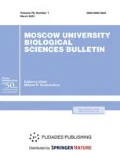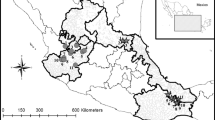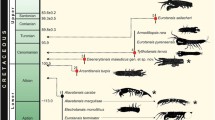Abstract
Anabantoid fishes comprise a unique group, most of whose representatives are characterized by diverse forms of parental care. Evolutional reconstruction of the reproductive strategies of anabantoids is challenging, partly due to the lack of reliable evidence of parental care in a number of its representatives, the most famous of which is the climbing perch. Moreover, apparent contradictions between literary sources frequently occur on the subject. This brief overview attempts to analyze the situation and identify the possible causes of disagreement. The further development in understanding the phylogeny of life history strategies in the group, as well as the concept of evolutionary transitions among parental care patterns in fishes in general, depend on the clarification of this situation.
Similar content being viewed by others
REFERENCES
Mookerjee, H.K. and Mazumdar, S.R., On the life history, breeding and rearing of Anabas testudineus Bloch, J. Dep. Sci. Cal. Univ., 1946, vol. 2, pp. 101–140.
Sarkar, U.K., Deepak, P.K., Kapoor, D., Negi, R.S., Pau, S.K., and Sing, S., Captive breeding of climbing perch Anabas testudineus (Bloch, 1792) with Wova-FH for conservation and aquaculture, Aquac. Res., 2005, vol. 36, no. 10, pp. 941–945.
Zworykin, D.D., Reproduction and spawning behavior of the climbing perch Anabas testudineus (Perciformes, Anabantidae) in an aquarium, J. Ichthyol., 2012, vol. 52, no. 6, pp. 379–388.
Lowe-McConnell, R.H., Ecological Studies in Tropical Fish Communities, Cambridge: Cambridge Univ. Press, 1987.
Balon, E.K., Epigenesis of an epigeneticist: The development of some alternative concepts on the early ontogeny and evolution of fishes, Guelph Ichthyol. Rev., 1990, vol. 1, pp. 1–48.
Rüber, L., Britz, R., and Zardoya, R., Molecular phylogenetics and evolutionary diversification of Labyrinth fishes (Perciformes: Anabantoidei), Syst. Biol., 2006, vol. 55, no. 3, pp. 374–397.
Wu, F., He, D., Fang, G., and Deng, T., Into Africa via docked India: A fossil climbing perch from the Oligocene of Tibet helps solve the anabantid biogeographical puzzle, Sci. Bull., 2019, vol. 64, no. 7, pp. 455–463.
Zworykin, D.D., Phylogenesis of reproductive strategies in labyrinth fishes (Anabantoidei) and their sister groups, Biol. Bull. Rev., 2017, vol. 7, no. 5, pp. 428–441.
Balon, E.K., Reproductive guilds of fishes: A proposal and definition, J. Fish. Res. Board Can., 1975, vol. 32, no. 6, pp. 821–864.
Balon, E.K., Additions and amendments to the classification of reproductive styles in fishes, Environ. Biol. Fish, 1981, vol. 6, nos. 3-4, pp. 377–389.
Balon, E.K., Patterns in the evolution of reproductive styles in fishes, in Fish Reproduction: Strategies and Tactics, Potts, G.W. and Wootton, R.J., Eds., London: Acad. Press, 1984, pp. 35–53.
Norris, S.M., Microctenopoma uelense and M. nigricans, a new genus and two new species of anabantid fishes from Africa, Ichthyol. Explor. Fres., 1995, vol. 6, no. 4, pp. 357–376.
Welcomme, R.L., River fisheries, in F.A.O. Fisheries Technical Paper 262, Rome: F.A.O. U.N., 1985.
Verma, P.S., A Manual of Practical Zoology Chordates, Ram Nagar, New Delhi: S. Chand & Co. Ltd., 2000, 10th ed.
Lal, S.S., Practical Zoology: Vertebrate, Gangotri: Rastogi Publications, 2009, vol. 3.
Freshwater Pest Identification Guide, Dep. Agric. Water Resour., Aust. Gov., 2019.
FishBase. https://www.fishbase.se. Accessed July 25, 2020.
Climbing perch (Anabas testudineus), in Ecological Risk Screening Summary, U.S. Fish & Wildlife Service, F.A.C. Program, 2019.
Barlow, G.W., Liem, K.F., and Wickler, W., Badidae, A new fish family—behavioural, osteological, and developmental evidence, J. Zool., 1968, vol. 156, no. 4, pp. 415–447.
Kühme, W., Verhaltensstudien am maulbrütenden (Betta anabatoides Bleeker) und am nestbauenden Kampffisch (B. splendens Regan), Z. Tierpsychol., 1961, vol. 18, no. 1, pp. 33–55.
Zworykin, D.D., Some trends in freshwater tropical aquaculture and their impact on studies of reproductive biology of the climbing perch Anabas testudineus (Anabantidae), Ryb. Khoz., 2020, no. 4, pp. 85–89.
Zworykin, D.D., The behavior of climbing perch, Anabas testudineus, with novel food in individual and social conditions, J. Ichthyol., 2018, vol. 58, no. 2, pp. 260–264.
Candolin, U. and Voigt, H.-R., No effect of a parasite on reproduction in stickleback males: A laboratory artefact?, Parasitology, 2001, vol. 122, no. 4, pp. 457–464.
Behera, S., Ahmed, A.S., Kumar, S., Gogoi, R., Jomang, O., and Baksi, S., Courtship behaviour and breeding success of climbing perch, Anabas testudineus (Bloch) in three different breeding sets with the application of a synthetic hormone (WOVA-FH), Int. J. Fish. Aquat. Stud., 2016, vol. 6, no. 1, pp. 1–6.
Lee, J.S.F., Alternative reproductive tactics and status-dependent selection, Behav. Ecol., 2005, vol. 16, no. 3, pp. 566–570.
Taborsky, M. and Brockmann, H.J., Alternative reproductive tactics and life history phenotypes, in Animal Behaviour: Evolution and Mechanisms, Kappeler, P.M., Ed., Berlin: Springer, 2010, pp. 537–586.
McNamara, J.M., Houston, A.I., Szekely, T., and Webb, J.N., Do parents make independent decisions about desertion?, Anim. Behav., 2002, vol. 64, no. 1, pp. 147–149.
Lehtonen, T.K., Wong, B.B.M., Lindström, K., and Meyer, A., Species divergence and seasonal succession in rates of mate desertion in closely related Neotropical cichlid fishes, Behav. Ecol. Sociobiol., 2010, vol. 65, no. 4, pp. 607–612.
Warner, R.R., Wernerus, F., Lejeune, P., and van den Berghe, E., Dynamics of female choice for parental care in a fish species where care is facultative, Behav. Ecol., 1995, vol. 6, no. 1, pp. 73–81.
Pombal, J.P., Martins, M., and Haddad, C.F.B., Escalated aggressive behaviour and facultative parental care in the nest building gladiator frog, Hyla faber, Amphibia-Reptilia, 1998, vol. 19, no. 1, pp. 65–73.
Wootton, R.J. and Smith, C., Reproductive Biology of Teleost Fishes, Chichester: John Wiley & Sons, 2015.
Roberts, T.R., The Freshwater Fishes of Western Borneo (Kalimantan Barat, Indonesia), San Francisco: Calif. Acad. Sci., 1989.
Haniffa, M.A., Nagarajan, M., Marimuthu, K., and Raj, A.J.A., Embryonic and larval development of spotted murrel, Channa punctatus (Bloch), Indian J. Fish, 2003, vol. 50, no. 3, pp. 355–362.
Parameswaran, S. and Murugesan, V.K., Observations on the hypophysation of murrels (Ophicephalidae), Hydrobiologia, 1976, vol. 50, no. 1, pp. 81–87.
Shrestha, T.K., Resource Ecology of the Himalayan Waters: A Study of the Ecology, Biology and Management Strategy of Fresh Waters of Nepal, Kathmandu: Steven Simpson Books, 1995.
Vann, L.S., Baran, E., Phen, C., and Thang, T.B., Biological Reviews of Important Cambodian Fish Species, Phnom Penh: WorldFish Center, 2006, vol. 2.
Rajan, D.S., An evaluation of the effect of a detergent on dissolved oxygen consumption rate of Anabas testudineus, Int. J. Fish. Aquat. Stud., 2015, vol. 2, no. 6, pp. 46–48.
ACKNOWLEDGMENTS
I thank Đinh Thị H\(\overset{,}{\text{a}}\)i Y\({\tilde {\text{e}}}\)n and Vo Thị Ha for long-term collaboration in the study of the climbing perch and D.S. Pavlov, K.F. Dzerzhinskiy, and an anonymous reviewer for fruitful discussion of certain theses of this manuscript.
Funding
This study was performed within the framework of the Ecolan E-3.2 program of the Vietnam–Russian Tropical Research and Technological Centre.
Author information
Authors and Affiliations
Corresponding author
Ethics declarations
COMPLIANCE WITH ETHICAL STANDARDS
The authors declare that they have no conflict of interest. This article does not contain any studies involving animals or human participants performed by any of the authors.
ADDITIONAL INFORMATION
Additional information
Translated by T. Kuznetsova
About this article
Cite this article
Zworykin, D.D. Parental Care in the Climbing Perch (Anabas testudineus): Confusion or Lost Data?. Moscow Univ. Biol.Sci. Bull. 75, 237–241 (2020). https://doi.org/10.3103/S0096392520040148
Received:
Revised:
Accepted:
Published:
Issue Date:
DOI: https://doi.org/10.3103/S0096392520040148




